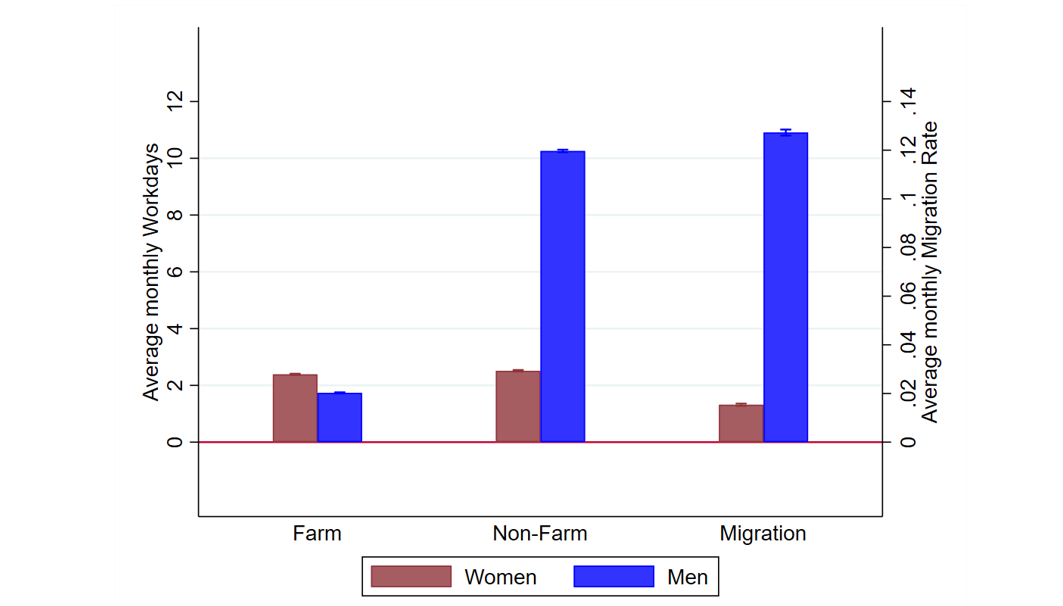
Climate change is increasing rainfall uncertainty, which has gendered impacts on rural labour markets. After droughts, women are less likely to access non-farm employment through migration than men, exacerbating existing occupational gender gaps
Climate change has not only raised average temperatures, but also increased the incidence and severity of extreme weather events such as droughts (IPCC Report 2021). This puts agriculture in rain-fed regions — more than 75% of the world's cropped land – at high risk. The increased variability in rainfall makes agricultural incomes and employment prone to productivity shocks, particularly in developing countries where agricultural systems are mostly rain-fed and managed by vulnerable communities. In these regions, the absence of social insurance and incomplete credit markets underscores the importance of labour as a coping mechanism by households when faced with such adverse shocks. Furthermore, such negative productivity shocks can exacerbate gender disparities, more so in contexts where women’s access to off-farm work may be constrained (see Figure 1).
Figure 1: Type of work and migration, by gender (rural India)

Note: ICRISAT-VDSA (https://vdsa.icrisat.org/vdsa-microdoc.aspx ) data (2010-14). Authors’ own calculations. The Y-axis shows the average number of work days per month for farm and non-farm work on the left-hand and the average migration rate per month on the right.
Labour market impacts of droughts in rural India
India, with 40% of its workforce employed in the agriculture sector, has experienced an
increased incidence, duration and intensity of droughts over the last century (see Figure 2).
Figure 2: Frequency, duration and intensity of droughts in India (1901-2017)


Source: Indian Meteorological Department (IMD) data (1901-2017); Authors’ own calculations.
Note: A drought is defined to occur when the monsoon rainfall in a grid lies in the bottom two deciles of the long-run distribution (1901-2017). Figure (a) plots the five-year moving average of the Frequency of droughts. Figure (b) plots the duration as measured by the Length of drought – the average number of drought years in each grid experienced in the preceding decade. Figure (c) plots the five-year moving average of Intensity of drought – the standard deviation of monsoon rainfall in a grid from its long-run average during the drought year.
In our recent research (Afridi et al. 2022), we examine the impact of adverse agricultural production shocks caused by droughts on labour market dynamics, using monthly individual-level panel data collected by ICRISAT during 2010-14, covering eight agro-climatic zones in India. Utilising this high frequency data we estimate the short-term impact of deficient rainfall on individuals’ overall labour force participation, employment on the farm and diversification towards the non-farm sector on both the extensive and intensive margins in rural areas. Unlike conventional household surveys that do not collect data on temporary migrants, this data allow us to investigate seasonal migration as a mechanism for coping with agricultural shocks, and the accessibility of non-farm employment opportunities, which are considerably farther (more than 3800 km relative to 75 kms for farm work) and offer a higher wage (almost double that of farm labour). More importantly, we highlight the gendered access to migration as a coping mechanism, and its potential to exacerbate gender inequalities in the labour market.
Gendered effects of droughts
Our results reveal significant gender disparities in terms of the labour market outcomes of men and women in response to drought shocks (see Figure 3). Women are 7.1% less likely to be employed compared to men and 80% more likely to seek work in a drought year. On the intensive margin, women’s workdays fall by 19%, relative to that of men, as men increase their non-farm workdays by 22.5%. We find no significant impact on women’s engagement either in the farm or the non-farm sector, resulting in a 20.1% decrease in women’s non-farm workdays relative to men’s during a drought. Hence, while men diversify their sources of income to cope with droughts, by taking on non-farm sector jobs, women stay in the farm sector despite seeking work elsewhere, and their real farm wage earnings (conditional on being employed on the farm) and real daily wage rates fall by 38.1% and 11.4%, respectively.
These findings are robust to potential confounders, including individual characteristics, seasonality, secular and village specific trends, and are also held up by nationally representative district-level panel data.
Restricted mobility of women
Our research shows that the restricted mobility of women is a key factor in limiting their ability to respond to a drought shock (see Figure 3). Women’s lack of diversification to non-farm work is further constrained by prevalent social norms in the Indian context.
To elaborate, we find that women are less likely than men to work outside the village or migrate, on average, and this is amplified by drought shocks. The likelihood of men taking up work outside the village and migrating in response to a drought shock increases by 1.7 percentage points and 0.8 percentage points, respectively, but there is no notable change in the workplace location of women. The differential mobility impacts their earnings, as men make 18.6% higher non-farm earnings relative to women during droughts.
Furthermore, our findings show that women who are younger, married and have young children are not only less likely to diversify their labour to the non-farm sector, but are also less likely to migrate relative to men with the same characteristics during a drought. This suggests that rigid gender norms which burden women with home production and care responsibilities, coupled with concerns around women’s sexual ‘purity’, may inhibit their access to job opportunities beyond their immediate vicinity.
While we do not find evidence in support of gender skill differentials or safety concerns as possible explanation of our findings, we are unable to test for gender-differentiated changes in demand for labour in the farm and non-farm sectors, due to data constraints.
Figure 3: Impact of droughts on type of work and migration, by gender

Note: ICRISAT-VDSA data (2010-14). Authors’ own calculations. The Y-axis shows the estimated regression coefficient on ‘Drought’. On the left are the estimated effects of a drought on the average number of days worked (per month) on the farm and non-farm; on the right is the estimated effect of a drought on the probability of migration.
Policy implications
Our study underlines the importance of policies that encourage greater mobility of women and the need to improve non-farm work opportunities within rural areas. We show suggestive evidence of the potential of public employment programmes that provide work within villages. These programmes not only cushion the short-run production risks in agriculture but can also bridge gender disparities in employment opportunities.
Concluding Remarks
In contrast to the existing literature, which shows that women’s employment increases in response to negative household level idiosyncratic income shocks in low-income economies, we find that while women are more likely to seek work due to negative aggregate income shocks, their employment may not increase if their labour mobility is limited. Additionally, climatic shocks may have long-term effects. Our cross-sectional estimates indicate that gender gaps in non-farm employment and migration are larger in villages facing higher risks from rainfall variability, suggesting that men may permanently shift their occupational structure to the less risky non-farm sector, increasing the share of non-farm employment in the economy but exacerbating occupational segregation by gender.
References
Afridi, F, K Mahajan, and N Sangwan (2022), “The gendered effects of droughts: Production shocks and labour response in agriculture” Labour Economics, 78: 102227.
IPCC (2021), Climate Change 2021. Available here: https://www.ipcc.ch/report/ar6/wg1/downloads/report/IPCC_AR6_WGI_SPM.pdf.


